The Chuwi LapBook 14.1 Review: Redefining Affordable
by Brett Howse on March 10, 2017 8:00 AM ESTGPU Performance
The other upgrade in Apollo Lake was the move to Intel’s Gen 9 graphics. For a full breakdown of what this offers, check out Ian’s Skylake analysis. The main takeaways though are better media capabilities, and better performance.
The Chuwi LapBook 14.1 offers the Intel HD Graphics 500, with 12 Execution Units (EUs) on its implementation, with a boost frequency up to 700 MHz. This is likely close to the performance of something like a Pentium 4405Y, which is a Skylake 6-Watt processor, with the same 12 EUs, but with the Skylake part offering 100 MHz higher boost. Compared to even a Y series Intel Core though, the Atom only offers half of the EUs of the Intel HD Graphics 515, so we can’t get our hopes too high.
Compared to the other Atom devices we’ve tested in the last couple of years, the Microsoft Surface 3 has 16 Gen 8 EUs, but only up to 600 MHz and in a 2-Watt SDP. The HP Stream 11 has only 4 EUs in it’s much older Bay Trail-M platform, with a boost up to 792 MHz.
3DMark
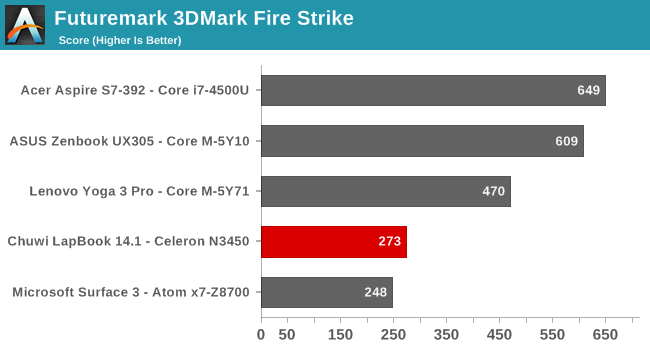
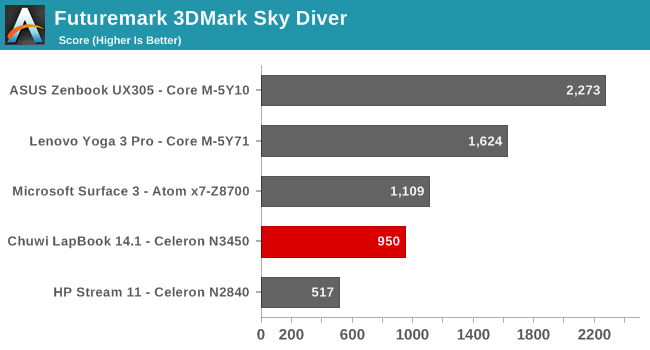
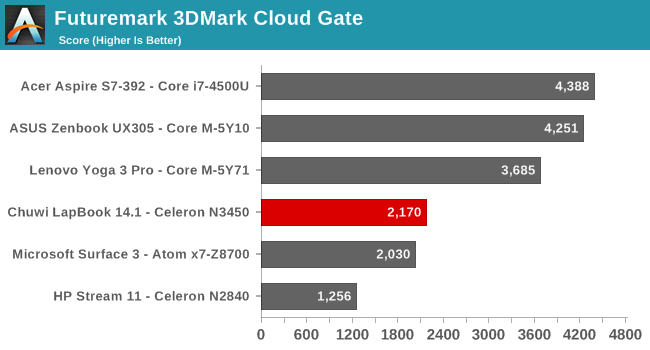

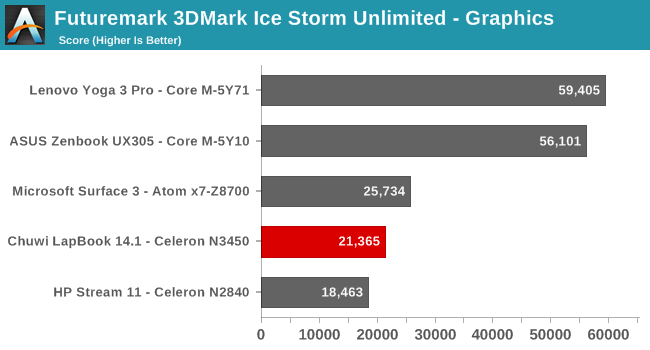
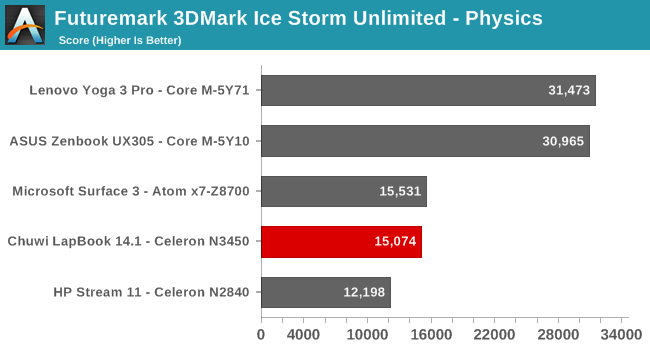
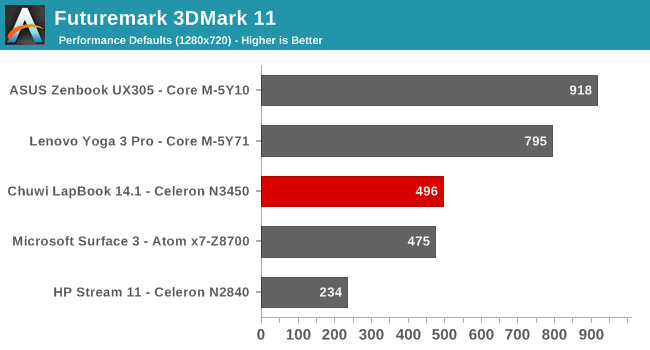
Futuremark’s 3DMark is a synthetic graphics benchmark, but it does offer several tests with increasing complexity. Fire Strike is for devices with dGPUs, Sky Diver is slightly less demanding, followed by Cloud Gate for lower cost devices, and Ice Storm Unlimited which is for smartphones and tablets. It’s interesting to see how the Celeron N3450 stacks up here, with it trading blows with the Microsoft Surface 3. Despite half the SDP available, the Surface 3 does have 16 EUs versus just 12 EUs in the Celeron, and the wider graphics pipeline lets it beat the newer Gen 9 graphics in both the Sky Diver test, and Ice Storm Unlimited. It’s even more interesting that the Atom x7-Z8700 outperforms the Celeron N3450 in the Ice Storm Unlimited Physics test, which is a CPU test. Intel has a bit of work to do here.
GFXBench
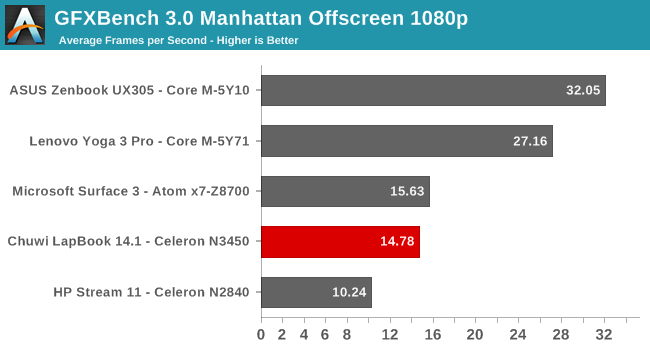

Kishonti’s GFXBench is another synthetic test, with several different tests available. It’s been updated to version 4, and it now includes several tests which were not part of our testing suite a few years ago, but they have kept their older tests as well. Once again, the Surface 3 outperforms the Chuwi in the Manhattan test, which is the more complicated of the two. T-Rex is a win for the Gen 9 graphics though. It’s a big step up from the 4 EU HP Stream 11 on both tests though.
Dota 2

We’ve been using Valve’s Dota 2 as a real-world benchmark for lower end systems for a while now, but unfortunately for us (but less so for Valve’s customers) Valve updated the game to a new engine, which means our old results are no longer comparable to the new tests. As such, none of the devices compared with the Chuwi. Instead I’ve added the Microsoft Surface Book with Core i5-6300U to compare it against a 15-Watt Skylake CPU’s integrated GPU. The results speak for themselves. Despite this test being run on our lowest settings, the Celeron N3450 ends up about 25% the speed of a Skylake 24 EU GPU on this test, and is unplayable.
GPU Conclusion
Intel has steadily been increasing its GPU performance, as well as dedicating more die space to the GPU. With the Celeron N3450, 12 EUs and 700 MHz is not enough for anything but the most basic graphics task. Dota 2, which can be played at 60 frames per second on an Ultrabook with integrated GPU, only ends up getting 14 frames per second. Interestingly, the Cherry Trail based Surface 3 outperforms the latest Gen 9 graphics as well in several tests, thanks to its 16 EUs compared to just 12 on the Apollo Lake SoC. The wider and slower Cherry Trail offers a bit more oomph in several scenarios, despite its older graphics core, with a slower clock speed, and half the scenario design power. Intel does offer up to 18 EUs on the Pentium N4200 Apollo Lake, but the rest of the Apollo Lake lineup is shackled with only 12 EUs. No one would expect the Chuwi LapBook 14.1 to be a gaming system, but unlike the CPU, the GPU is a long way from a good experience.
Storage Performance
Chuwi offers just a single model in the LapBook 14.1 series, and that is a 64 GB model. Compared to the HP Stream 11, which is still sold as a 32 GB model, this is a big jump. Even with the changes to Windows 10 to improve the usability of low storage devices, 32 GB is going to end up being something you will need to manage, whereas 64 GB gives a lot more breathing space. It is expandable by microSD card as well, up to another 128 GB, which should be enough storage for anyone shopping for something in this price range.
Of course, being that this is a low-cost notebook, the storage is not a Solid-State design, but is instead eMMC. As with all flash memory though, more storage can help with parallelism, and therefore performance, so let’s see how the Chuwi LapBook looks.
Read speeds of 165 MB/s and write speeds of 105.8 MB/s are a long way from any modern SSD, but it’s certainly respectable. The small 4K file sizes are quite a bit slower, and disk performance is not the strong suit of this notebook, but it does fall into the norms for any eMMC based device. In day to day use, the storage speed is noticeable, but unless you are doing large file work, which is not really something that is suitable for this kind of machine, it’s fine. Boot speeds and program launch speeds are very reasonable, with Windows 10 booting from the Chuwi logo to the Windows 10 desktop in about 18 seconds. Really the main thing is that Chuwi has outfitted the notebook with 64 GB of storage, making it a lot easier to live with than a 32 GB model would have been.


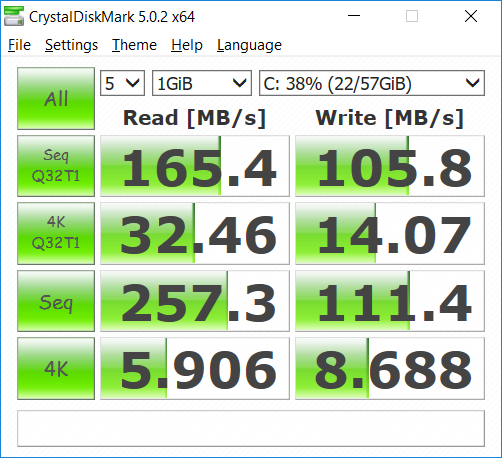








75 Comments
View All Comments
BrokenCrayons - Friday, March 10, 2017 - link
Here's a link to a reviewer that tested the Lapbook with Ubuntu:http://www.cnx-software.com/2017/02/07/installing-...
The results look promising.
tipoo - Friday, March 10, 2017 - link
If I could don my tin hat for only a few seconds...Has anyone ever looked at the outbound traffic on these lesser known Chinese designed electronics? There was some controversy with Xiaomi router traffic even iirc.
BrokenCrayons - Friday, March 10, 2017 - link
A quick search didn't turn up anything. I don't think they're selling in large enough numbers to attract a lot of interest in sniffing their outbound traffic. It's a reasonable concern, but I don't think Chuwi would actively attempt to perform mass data collection. That's a pretty widely cast net that wouldn't reap much value because you're probably looking at largely home users. The data collection would be almost entirely uninteresting. Maybe some social networking, shopping and general web browsing, someone's hidden inappropriate photos and videos...that kind of thing isn't worth a lot unless you have a specific target in mind and in that case its more prudent to isolate that individual rather than everyone buying your products. Probably the best you'd get is access to someone's personal finances and a deep enough investigation would do a lot of damage to business interests. It's really worth more to establish a good brand reputation and land decent numbers of sales than it is to go through the trouble of getting one or two generations of hardware out there to a small number of people that probably are collectively deep in debt and have little liquid cash.fanofanand - Monday, March 13, 2017 - link
I think the concern would lay more on the government's involvement (The Chinese government is involved with virtually all exported electronics). I agree with every single thing you wrote, but Chinese businesses don't all exist for the sole purpose of making money.Bullwinkle J Moose - Friday, March 10, 2017 - link
Good point tipooThis article just today and all the turmoil at Samsung and S Korea makes me think we should be looking out for malware popping up in other places
Even places we have considered to be quite reliable up till now
https://arstechnica.com/security/2017/03/preinstal...
Things seem to be escalating but I'm sure the CIA will put a start to any malware threats to this Country (LOL)
Murloc - Saturday, March 11, 2017 - link
to make such low costs devices you buy standard chips so I don't think they can put anything in it.If chinese-designed chips have espionage software in them, then a bunch of the network infrastructure we rely on is bugged because huawei is everywhere in them. Also phones that use mediatek devices.
So worrying doesn't make sense, also because it's well-known from the various leaks and stuxnet that the NSA and the CIA and mossad don't need hardware to snoop or damage critical infrastructure so the chinese don't either.
Meteor2 - Friday, March 10, 2017 - link
Nice review of a nice machine.Good to read about how Goldmont finally played out. MS must've been pissed when Intel cancelled Broxton, but I imagine it's now Intel's turn with Windows on 835 coming. It's a shame Intel did what they did as Goldmont appears to be good silicon.
aryonoco - Friday, March 10, 2017 - link
The main competition in this price category is Chromebooks.The fact that you are pitting this device in your comparisons against a Yoga 3 Pro and a Asus UX305, and not a single Chromebook, says all that needs to be said about the sorry state of AT these days.
Sure, I miss Anand & Brian, but when they left we got Jarred Walton Andrei Frumusanu, who at least knew what they were talking about. Ryan, these new writers you have hired do not stack up.
Ian Cutress - Saturday, March 11, 2017 - link
To clarify an obvious error: Jarred was here 10 years, and both Andrei and Brett were here well before Anand left. Brett has been one of our freelance editors for over two years and attends events such as CES and Build as our Senior Laptop Editor. If you dislike the context of this review, sure, I'll grant you that opinion, but he has a large body of great work under him already. He's not new, he knows the score.On the testing front, it's a factor of what we get in for testing at any given time. Ultimately 90% of the time vendors want us to test their premium units, not something low cost. And there's a thousand low-cost options out there to potentially compare them against. When you've got a freelancer with time for 6-10 reviews a year, most of those will be high-end premium reviews. So if something interesting comes along, even at a super low price point, you compare against what you can or have at the time.
Which in this case, the HP Stream 11 is the perfect comparison point for all these benchmarks. The Yoga/Surface are added to show the comparison to what a high-end notebook investment would be, which users always want to know without having to dig through our results database. We do have some Chromebooks in our database, but they are old. We haven't tested one in a long while (so we don't have one in for retesting), and they were all done by a different reviewer over 1000 miles away at the time. Most of the Chromebooks are Atom based anyway, which is why the HP Stream is still a relevant comparison. Heck, I even recommended the Stream 11 to someone I know a couple of weeks ago, and she loves it (especially now there's a 360-degree hinge version).
fanofanand - Monday, March 13, 2017 - link
I get what the OP is saying but it is misguided in this case. Brett's reviews are solid. Some of the review product choices (case and PSU reviews) have been questionable but other than mobile reviews I haven't seen a real decline in the quality of Anandtech's journalism. Yes, they have had some major misses in the last year (especially in the GPU space) but what they have actually written has been fairly solid content.